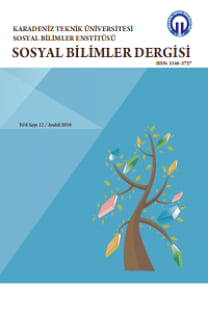SÜRDÜRÜLEMEYEN BARIŞ İNŞASINDA SİYASAL KÜLTÜRÜN ROLÜ: HAİTİ ÖRNEĞİ
Soğuk Savaş’ın sona ermesiyle beraber dünyanın birçok yerinde baskılanan çatışmaların gün yüzüne çıktığı görülmektedir. Diğer yandan, çatışmaların çözümü, barış safhalarının başlatılması, korunması ve kontrolünde uluslararası örgütlerin çeşitli faaliyetler yürüttüğü bilinmektedir. Bu örgütler arasında en aktif role sahip olan Birleşmiş Milletler (BM)’dir. Bu çalışmada, Haiti’de meydana gelen çatışmalar ve çatışmaların nedenleri farklı dönemler kapsamında ele alınmış ve BM’nin mevcut çatışmalar karşısındaki barış inşası süreçleri incelenmiştir. Çalışmadan elde edilen bulgulara göre hem Haiti’ye ait hem de müdahaleci devletlerin bölgeye taşıdığı siyasi kültür, meydana gelen çatışmaların temel nedeni olarak görülmektedir. Ayrıca yaşanan çatışmalar karşısında BM’nin oluşturduğu barış inşası çalışmalarının, kısa vadede çatışmaları durdurduğu ancak uzun vadede pozitif barışı inşa edemediği\koruyamadığı sonucuna ulaşılmıştır.
Anahtar Kelimeler:
Barış İnşası, Sürdürülebilirlik, Siyasal Kültür, Haiti, Barış Operasyonu
THE ROLE OF POLITICAL CULTURE IN UNSUSTAINABLE PEACE-BUILDING: THE CASE OF HAITI
With the end of the Cold War, it is seen that the suppressed conflicts in many parts of the World have appeared. On the other hand, it is known that international organizations carry out various activities in the resolution of conflicts, the initiation of peace phases, its protection, and control. Among these, the United Nations (UN) is an organization that has the most active role. In this study, while the conflicts that took place in Haiti and the causes of the conflicts are discussed in the context of different periods; the peacebuilding processes of the United Nations against the current conflicts are examined. According to the findings obtained from the study, the political culture of both Haiti and the interventionist states brought to the region is seen as the main reason for the conflicts. In addition, it is concluded that the peacebuilding efforts created by the UN stopped the conflicts in Haiti in the short term, however, it could not build/preserve positive peace in the long term.
Keywords:
Peacebuilding, Sustainability, Political Culture, Haiti, Peace Operation.,
___
- Anadolu Ajansı (2020). 2020'de Öne Çıkan Çatışma ve Potansiyel Risk Bölgeleri, https://www.aa.com.tr/tr/dunya/2020de-one-cikan-catisma-ve-potansiyel-risk-bolgeleri-/1697337, (09.10.21).
- Bateson, G., (1935). Culture Contact and Schismogenesis, Man, 35, 178-183.
- Bilgin, K. (2012). Köleliğin Tarih Yapıcılığı, Mülkiye Dergisi, Ankara, 36 (4), 155-208.
- BM (1992). An Agenda for Peace Preventive Diplomacy, Peacemaking and Peace-keeping, https://www.un.org/ruleoflaw/files/A_47_277.pdf, (02.06.2021).
- Country Review, (2019). Haiti Review, http://www.countrywatch.com/Content/pdfs/reviews/B39M6MQ9.01c.pdf, (29.06.2021).
- Dayan, J. (1998). Haiti History and The Gods, University of California Press, California.
- Dizdaroğlu, C. (2019). Barış İnşası, Güvenlik Yazıları, No:13, https://trguvenlikportali.com/wpcontent/uploads/2019/10/BarisInsasi_CihanDizdaroglu_v.2.pdf, (06.06.2021).
- Egset, W. (2007). Social Resilience and State Fragility in Haiti, USA: World Bank Country Studies, Washington.
- Ekmekçi, F., (2011). Demokratik Barış Teorisi: Bir Değerlendirme, Uluslararası Hukuk ve Politika, 7 (26), 107-124.
- Erzen, M. Ü. &Yalın B., E., (2011), “Siyasal Kültürün Temel Paradigmaları Üzerine: Kültürden, Siyasal Toplumsallaşma, Örgütlenme ve Katılma Süreçlerine Yansıyanlar”, İletişim Fakültesi Dergisi, 41, 50-61.
- Galtung, J. (1976). Three Approaches to Peace: Peacekeeping, Peacemaking and Peacebuilding, J. Galtung (der.), Peace, War and Defence: Essays in Peace Research, Copenhagen: Ejlers.
- Goldstein, J. & Pevehouse, J. (2015). Uluslararası İlişkiler, Çev.: Haluk Özdemir, BB101 Yayınları, I. Baskı, Ankara.
- Haggerty, R. (1989). Haiti: Bir Ülke Çalışması, Washington: Kongre Kütüphanesi, GPO, http://countrystudies.us/haiti/, (21.06.2021).
- İnsamer (2020). HAİTİ, https://insamer.com/tr/haiti_1765.html, (20.06.2021).
- Köse, T. (2016). Barış Gücünün Tanımı ve Kapsamı, SETA, https://www.setav.org/baris-gucunun-tanimi-ve-kapsami/, (06.06.2021).
- Lantis, J. (2002). Strategic Culture and National Security Policy, International Studies Review, 4(3), 87-113.
- Lederach, J. P. (1997). Building Peace: Sustainable Reconciliation in Divided Societies, United States Institute of Peace Press, Washington, DC.
- MacGinty, R. (2010). Hybrid Peace: The Interaction Between Top-Down and Bottom-Op Peace, Security Dialogue, 41(4), 391-412.
- Özerdem, A. (2013). Barış İnşası Kuram ve Uygulaması, Nobel Yayınları, I. Basım, Ankara.
- Özerdem, A. (2013). Savaş Sonrası Yeniden Yapılanma Eski Savaşçıların Silahsızlandırılması, Terhisi ve Yeniden Entegrasyonu, Çev. CESRAN, Nobel Yayınları, Ankara . Öztekin, A. (2011). Siyaset Bilimine Giriş, Siyasal Kitabevi, 9 Baskı, Ankara.
- Richmond, O. (2006). The Problem of Peace: Understanding the Liberal Peace, Conflict, Security & Development, Cilt 6 (3), 291-314.
- Richmond, O. (2008). Peace in International Relations, Routledge, New York.
- Ryan, S. (2013). The Evolution of Peacebuilding, R. Mac Ginty (der.), Routledge Handbook of Peacebuilding. New York: Routledge, 25-36.
- Verner, D. (2007). The Haitian People: Demographics, Poverty, and Socioeconomic Outcomes and Risks, The Worldbank, 7-42.
- ISSN: 2146-3727
- Yayın Aralığı: Yılda 2 Sayı
- Başlangıç: 2011
- Yayıncı: Karadeniz Teknik Üniversitesi Sosyal Bilimler Enstitüsü
Sayıdaki Diğer Makaleler
DOĞU AKDENİZ ENERJİ REKABETİNDE LİBYA
ÇAYKUR’UN TÜRKİYE VARLIK FONU’NA DEVRİNİN VE FİNANSMAN SORUNUNUN ANALİZİ
Pelin MENGİ, Ebru SAYGILI, Seher GÖREN YARGI
TÜRKİYE’DE HAVA KALİTESİNİN COVID-19 BAĞLAMINDA DEĞERLENDİRİLMESİ
Abdulgazi YIKICI, Hüseyin ÜNAL
AFGANİSTAN’DA TALİBAN İKTİDARI DÖNEMLERİ (1996-2001 ve 2021 SONRASI) ve AFGANİSTAN DIŞ POLİTİKASI
SÜRDÜRÜLEMEYEN BARIŞ İNŞASINDA SİYASAL KÜLTÜRÜN ROLÜ: HAİTİ ÖRNEĞİ
Aslı Meryem ÇİLOĞLU, Ayça EMİNOĞLU
TÜRKİYE’DE İNTERNET KULLANIMININ MİKRO EKONOMİK ANALİZİ
EĞİTİMDE YAPAY ZEKÂNIN KULLANILMASI: BETİMSEL İÇERİK ANALİZİ ÇALIŞMASI
BATI DÜŞÜNCE TARİHİNDE BİREYİ ÖNCELEYEN DÜŞÜNÜRLERDE SİVİL TOPLUM VE DEMOKRASİ
